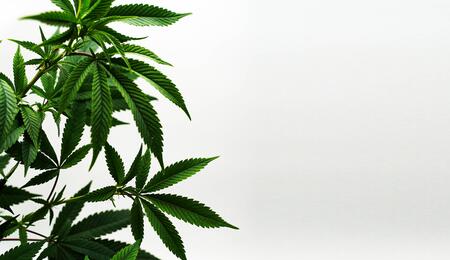Weedonomics

Cannabis sativa L. is without doubt the most widely produced, trafficked and consumed illegal drug in the world, with up to 650,000 hectares (ha) of land currently devoted to its cultivation worldwide. This total area is of course tiny compared to overall wheat cultivation (over 225 million ha) and that of the world's largest non-food crop (coffee, at 11.5 million ha); however, it is much larger than the area given over to cocaine (around 170,000 ha) and opium (around 185,000 ha).
The regions in which Cannabis can be grown are far greater in number than for opium and cocaine, which are geographically almost exclusively limited to Asia and South America, respectively. Total production of Cannabis far exceeds any other illicit drug, with up to 76,000 metric tons (t) produced annually – up to 66,000 t of herbal Cannabis, and up to 10,000 t of resin.
Opium stands at around 43,000 t and coca leaf at 150,000 t (although this figure is much bigger, the cocaine produced is only around 1,000 t). Total revenue from the global illegal Cannabis trade is estimated at around $142 billion (2010 figure) – over one-third of total illicit drug revenue worldwide ($411 billion). The cost of keeping Cannabis illegal is difficult to ascertain, due to the many factors at work, but is generally estimated to be at least $10 billion annually in the United States alone.
Taxes that would be gained if Cannabis was to be legalized are also difficult to determine, given that taxation systems are unlikely to be uniform worldwide; however, based on the idea that it would be taxed similarly to alcohol, billions could be generated globally. The human cost of the illegal Cannabis trade, again hard to measure, is without doubt massively increased by raising the severity of the measures taken against the trade, as evidenced by the horrific consequences of the drug war in Latin America.
This is prompting national leaders, such as Guatemalan president Otto Pérez Molina and Colombian president Juan Manuel Santos Calderón, to entirely rethink their policies towards all drugs – not just Cannabis. Of the total Cannabis produced worldwide, as much as 75% is destined for domestic consumption, with herbal Cannabis most often produced close to its ultimate point of consumption. Cannabis resin is more likely to be transported large distances due to the comparative ease of smuggling (particularly reduced smell and smaller volume).
It is almost impossible to discern with any accuracy the exact wholesale and production revenues for Cannabis, but estimates of around 5% of total retail revenue for growers and producers – and roughly 30% for wholesale revenues – have been postulated. Up to 255 million people worldwide use Cannabis regularly, with the highest consumption rates found in the United States, Canada and Australasia at around 10% of the population.
Tax revenue taken by the Netherlands amounts to approximately $600 million (from total sales of approximately $3.2 billion), with around 26.5 t sold and taxed annually in coffeeshops ($22.64 million per t or $2,264 per kg). If the entire global production of Cannabis were to be priced and taxed the same as the Netherlands, total global tax revenue would equate to almost $1.7 trillion annually (more than the current estimated world total for the sale of all illegal drugs combined). Of course, it is unlikely that all Cannabis produced would ever be subject to taxation – estimates suggest that up to 50% of alcohol produced globally is consumed with no tax paid at any stage – and even if it were, not every country is likely to levy such a high price or tax as the Netherlands (around 20% of retail sale price).
However, even if only half of total global production were taxed at an international average of (say) 10%, at current Netherlands retail prices this figure would amount to around $400 billion annually. In the United States, it is somewhat easier to gain a concise look at the economics of the Cannabis trade, but still not a simple procedure due to massive variation in state policies, and the emergence of the legal trade.
The fact that the United States is the single biggest national Cannabis market also means that accurately determining the figures is an arduous task, and there may therefore be considerable variation in the range of most estimates. When it comes to determining illegal trade statistics, the figures are usually worked out on the basis of total eradication and seizure amounts (which over the years have averaged around 10% of total production). America accounts for 70% of global seizures; estimates for the total value of the illegal market in the United States range from as little as $10 billion to as high as $120 billion annually, with most estimates putting it at around $40 billion.
The total revenue from legal medi-weed is estimated at around $1.7 billion (2011), a figure that almost equals the revenue from sales of Viagra, which is available in every state. US states where sales of Cannabis from dispensaries are taxed include California and Colorado. In San Francisco, whose dispensaries pay the standard 8.5% sales tax, medi-weed sales revenues represent a third of the city's total sales tax revenue. In Los Angeles, dispensaries have paid a standard 5% of gross retail revenue in tax since 2011, and in Berkeley, a 2.5% sales tax has been levied since 2010. Oakland voters agreed to raise tax paid from 1.8% - 5% on gross revenue, and dispensary owners also pay a $30,000 annual fee to the city. Total tax revenue taken in California is believed to approximate $100 million (2010 figure); the total in Colorado was around $5 million in 2011.
In states where sales tax is not levied, the state may still gain revenue from dispensary membership fees, such as in Oregon, where up to $6.7 million was raised in 2011. As Cannabis is illegal at the federal level, it is mostly untaxed beyond standard sales taxes. Upon legalization, it would be possible to tax weed similarly to alcohol, with increases in revenue expected at upwards of $30 billion nationally. It is estimated that California's retail prices for Cannabis would drop by as much as 80% if full legalization was to occur. Furthermore, California could see a 75% reduction in law enforcement costs, a figure of around $200 million, and generate at least $1.2 billion in tax – if a $50-per-ounce standard tax was levied, as well as sales tax.
Other savings are represented in the fact that costly and intrusive testing programs could be discontinued (such as mandatory drug testing for welfare recipients in Florida, which is estimated to have cost almost $120,000 despite leading to the detection of only 2.6% positive samples in the four months before it was put on 'temporary injunction' – due to lack of cost-effectiveness). One in four Americans live in medi-weed states, and it is estimated that up to 25 million adults could potentially qualify for prescription pot: currently, around 730,000 are registered Cannabis patients, and this figure is set to increase as more people become aware of their eligibility. Worldwide, a further 20,000 or so legally-prescribed patients exist in countries including the Netherlands, Canada and Israel.
Legalization would increase the numbers of medical users worldwide as it becomes increasingly acceptable to use and prescribe it, and new applications will undoubtedly be discovered. If complete global legalization were to be achieved, there would be various economic consequences. The cost of lobbying will undergo some changes: currently millions are spent annually on lobbying efforts to keep Cannabis illegal – this may see some increase if laws are to be relaxed, but it is also possible that opposition to legal Cannabis will slowly diminish (similar to the disinterest in post-Prohibition re-criminalization efforts).
Police and prison guard unions, privatized prisons, and alcohol and pharmaceutical corporations all have a massive vested interest in keeping Cannabis prisoners incarcerated for as long as possible. Until the system is entirely overhauled, lobbying efforts are unlikely to die off completely. On the other hand, the cost of lobbying to make Cannabis legal will inevitably experience great reduction as laws continue to relax.
Other factors to take into consideration include the fact that the total revenue from Cannabis is unnaturally high due to the associated costs of prohibition – the 'risk factor' becomes a priority at all stages of the industry, and this is usually relatively proportionate to the severity of risk. In those countries where the penalties are most severe, the cost of Cannabis is usually higher. These costs will be increased throughout every step of the process, from cultivation through transportation to retail sale.
Were Cannabis to be universally legalized, the risk factor would be removed and costs would reduce. This has been found to be the case in most countries that have attempted decriminalization or relaxation of Cannabis laws. Transportation would be further reduced by legalization due to the fact that domestic production could become a reality, and average distance from point-of-production to point-of-sale could be permitted to decrease. Many countries where outdoor cultivation is in fact possible, but local law precludes it, instead have growing or already-thriving indoor industries in place – Australia, much of the United States, many parts of southern Europe, and increasingly, Latin American countries such as Brazil. While outdoor cultivation occurs in most (if not all) of these locations, full legalization would in all likelihood see a reduction in indoor growing and a return to the far more cost-effective outdoor method.
However, if universal legalization were to occur, those countries whose climate is not well-adapted to production of high-potency Cannabis may swing the actual and environmental cost of cultivation back up, due to the expenses incurred with indoor cultivation. Furthermore, the total number of users may well increase if worldwide legalization occurs (currently there are 170 million alcohol users in the United States, compared with 16 million Cannabis users – a ten-to-one ratio), and cultural attitudes towards consumption of Cannabis become more relaxed.
It is vital that to accommodate such growth, there must be strong international dialog regarding how best to balance the growing demand with environmental concerns. The environmental cost of the Cannabis market is hard to measure, due to much of its excesses being due to illegality (in the form of dumping of hazardous waste that cannot be disposed of otherwise), eradication programs and fuel costs, among other factors. The associated costs of a global legal industry are still to be fully determined, but it is overwhelmingly clear that the costs of continued prohibition far outweigh them, and it is becoming apparent that the tide of public opinion is, throughout the world, beginning to sway in favor of legalization and regulation.
.jpg)


